Report: Reforms in the Education Sector in Australia, Economics
VerifiedAdded on 2020/03/01
|8
|1615
|120
Report
AI Summary
This report provides an in-depth analysis of the reforms in the Australian education sector, focusing on the economic impacts and government policies. It examines the importance of education for social and economic success in Australia, the government's expenditure, and the Senate's bills aimed at improving schools and universities. The report analyzes the context of a news article discussing these reforms, highlighting the government's efforts to reduce spending and the impact on students through loans and performance-based funding. It also emphasizes the need for improved quality of education, the importance of supporting underperforming students, and the need to learn from other countries' educational reforms. The report provides recommendations for educational institutions and the government, including the balance between centralization and decentralization of power. The paper concludes by emphasizing the education policy's focus on achieving economic growth and the importance of promoting excellence in teaching and learning.
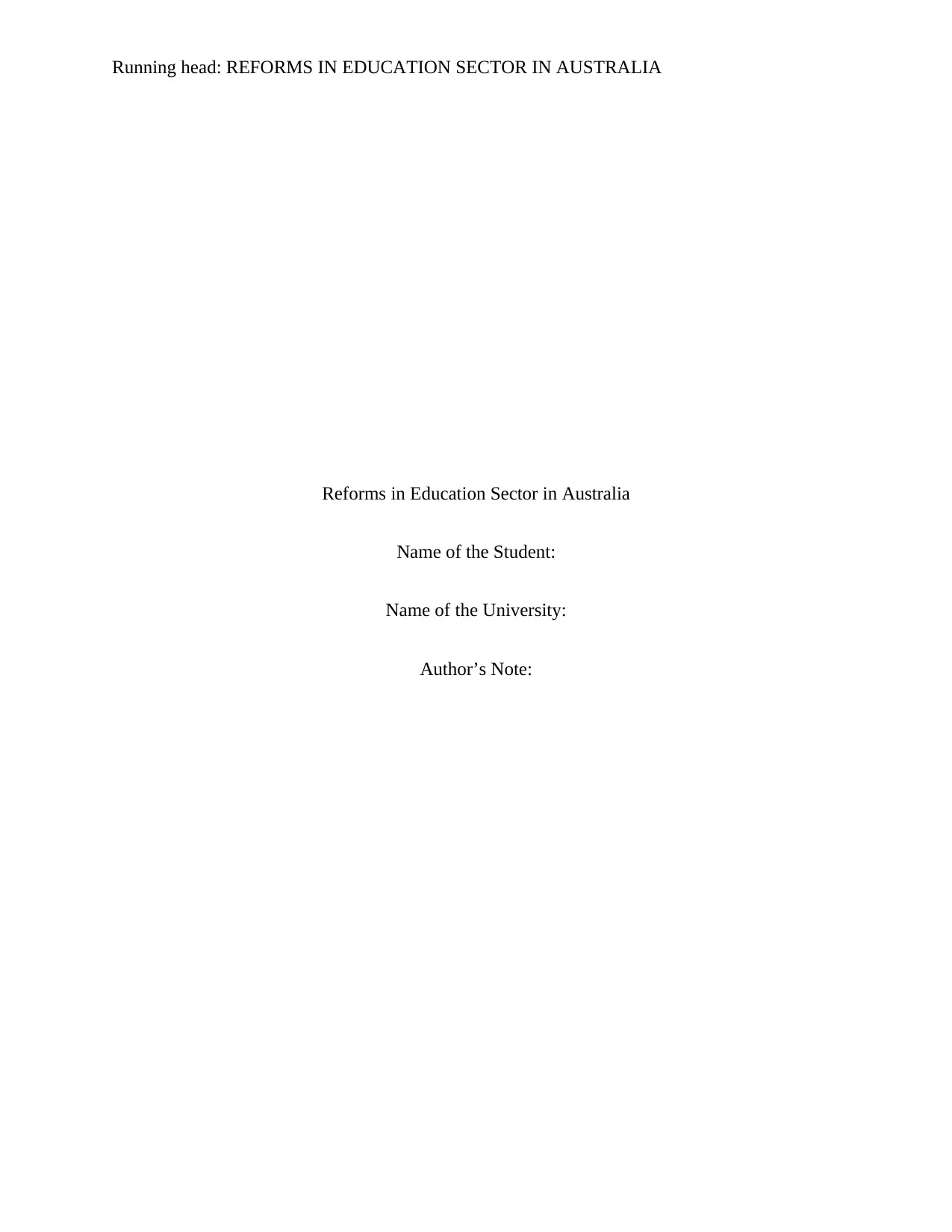
Running head: REFORMS IN EDUCATION SECTOR IN AUSTRALIA
Reforms in Education Sector in Australia
Name of the Student:
Name of the University:
Author’s Note:
Reforms in Education Sector in Australia
Name of the Student:
Name of the University:
Author’s Note:
Paraphrase This Document
Need a fresh take? Get an instant paraphrase of this document with our AI Paraphraser
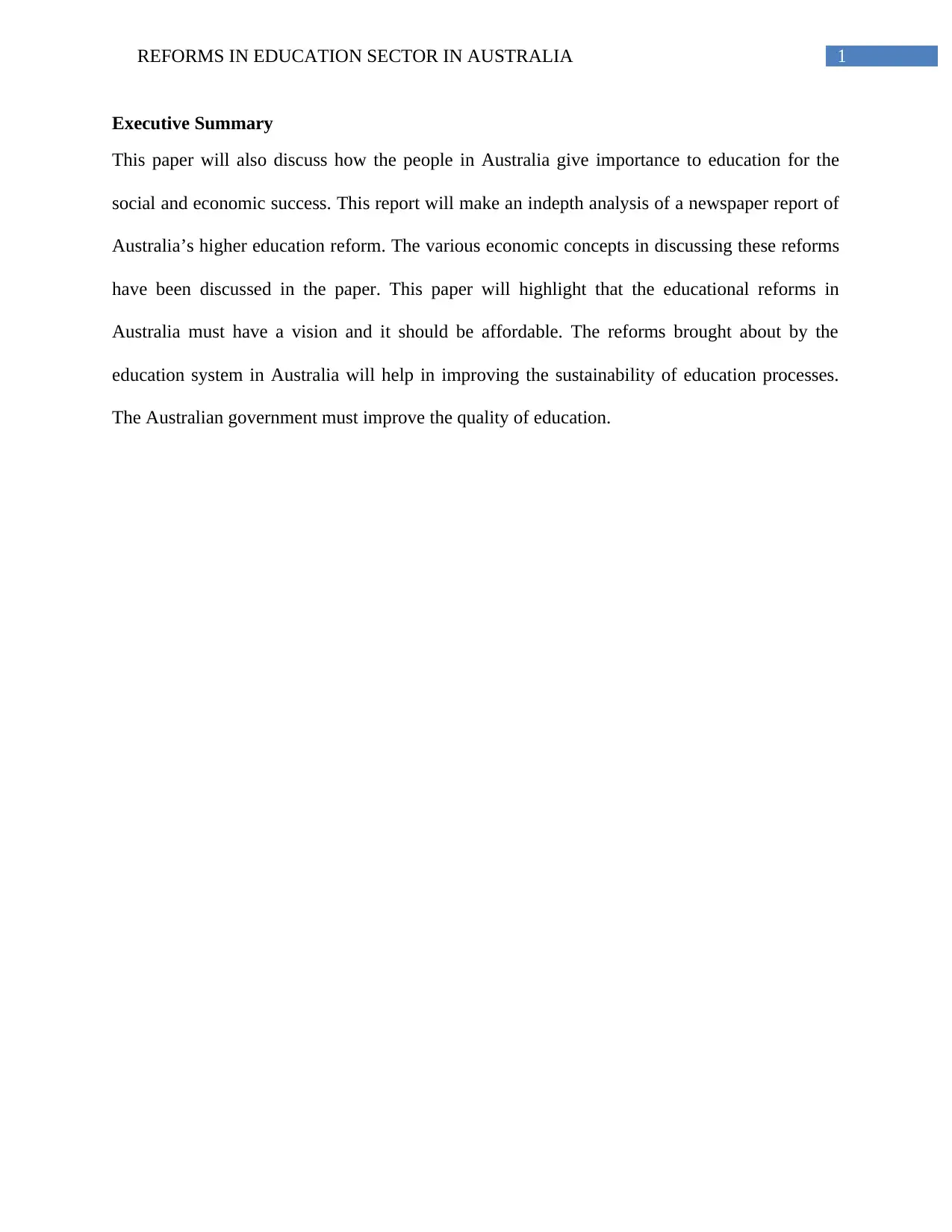
1REFORMS IN EDUCATION SECTOR IN AUSTRALIA
Executive Summary
This paper will also discuss how the people in Australia give importance to education for the
social and economic success. This report will make an indepth analysis of a newspaper report of
Australia’s higher education reform. The various economic concepts in discussing these reforms
have been discussed in the paper. This paper will highlight that the educational reforms in
Australia must have a vision and it should be affordable. The reforms brought about by the
education system in Australia will help in improving the sustainability of education processes.
The Australian government must improve the quality of education.
Executive Summary
This paper will also discuss how the people in Australia give importance to education for the
social and economic success. This report will make an indepth analysis of a newspaper report of
Australia’s higher education reform. The various economic concepts in discussing these reforms
have been discussed in the paper. This paper will highlight that the educational reforms in
Australia must have a vision and it should be affordable. The reforms brought about by the
education system in Australia will help in improving the sustainability of education processes.
The Australian government must improve the quality of education.
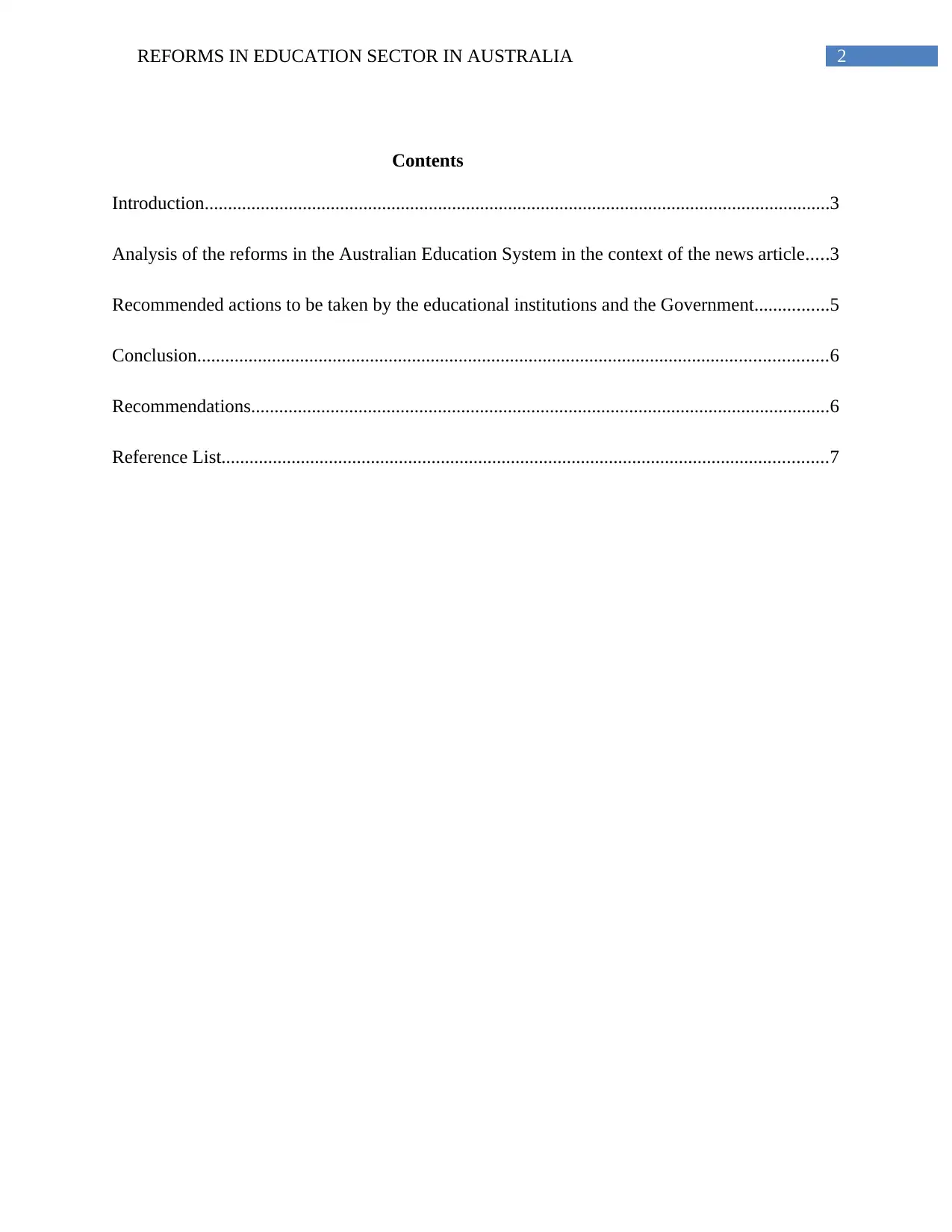
2REFORMS IN EDUCATION SECTOR IN AUSTRALIA
Contents
Introduction......................................................................................................................................3
Analysis of the reforms in the Australian Education System in the context of the news article.....3
Recommended actions to be taken by the educational institutions and the Government................5
Conclusion.......................................................................................................................................6
Recommendations............................................................................................................................6
Reference List..................................................................................................................................7
Contents
Introduction......................................................................................................................................3
Analysis of the reforms in the Australian Education System in the context of the news article.....3
Recommended actions to be taken by the educational institutions and the Government................5
Conclusion.......................................................................................................................................6
Recommendations............................................................................................................................6
Reference List..................................................................................................................................7
⊘ This is a preview!⊘
Do you want full access?
Subscribe today to unlock all pages.

Trusted by 1+ million students worldwide
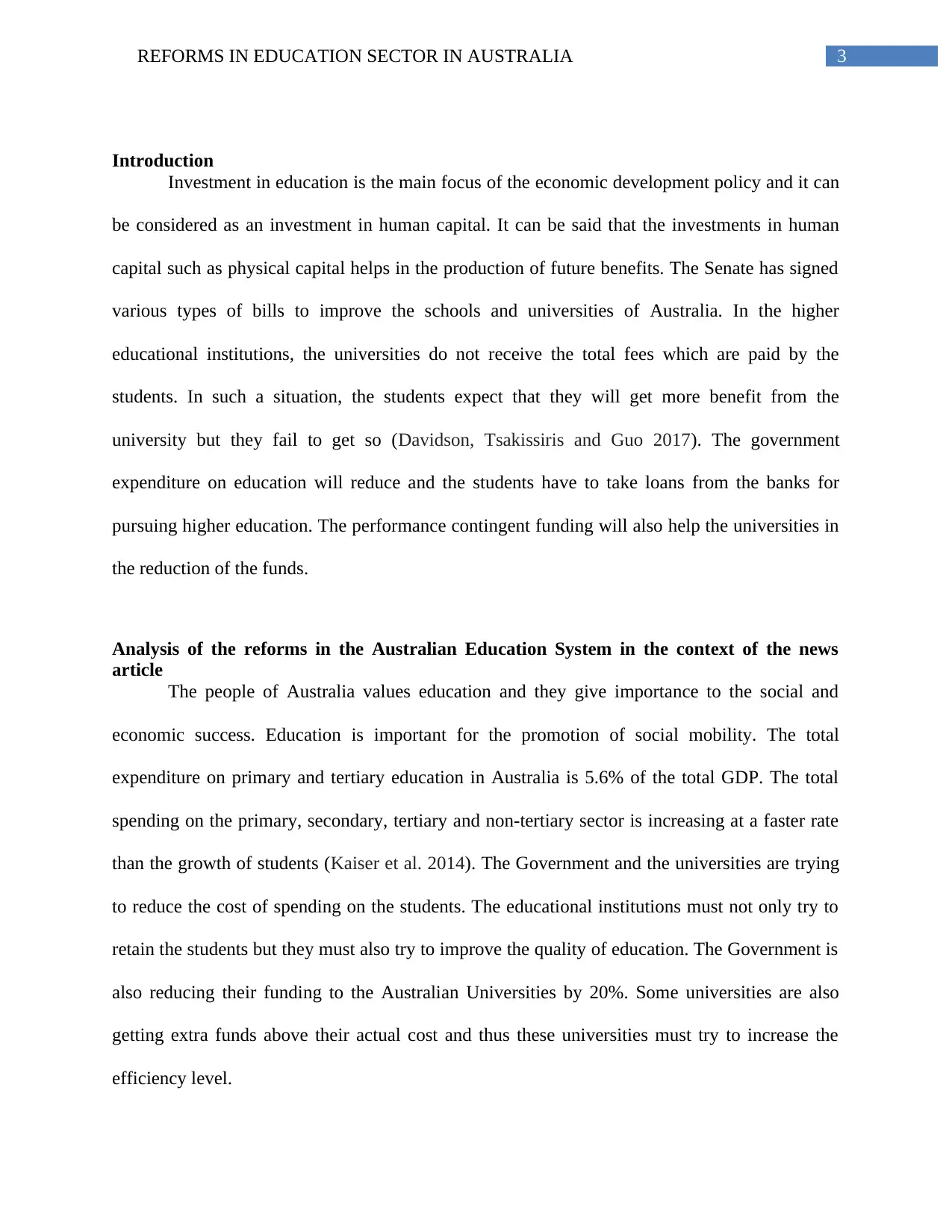
3REFORMS IN EDUCATION SECTOR IN AUSTRALIA
Introduction
Investment in education is the main focus of the economic development policy and it can
be considered as an investment in human capital. It can be said that the investments in human
capital such as physical capital helps in the production of future benefits. The Senate has signed
various types of bills to improve the schools and universities of Australia. In the higher
educational institutions, the universities do not receive the total fees which are paid by the
students. In such a situation, the students expect that they will get more benefit from the
university but they fail to get so (Davidson, Tsakissiris and Guo 2017). The government
expenditure on education will reduce and the students have to take loans from the banks for
pursuing higher education. The performance contingent funding will also help the universities in
the reduction of the funds.
Analysis of the reforms in the Australian Education System in the context of the news
article
The people of Australia values education and they give importance to the social and
economic success. Education is important for the promotion of social mobility. The total
expenditure on primary and tertiary education in Australia is 5.6% of the total GDP. The total
spending on the primary, secondary, tertiary and non-tertiary sector is increasing at a faster rate
than the growth of students (Kaiser et al. 2014). The Government and the universities are trying
to reduce the cost of spending on the students. The educational institutions must not only try to
retain the students but they must also try to improve the quality of education. The Government is
also reducing their funding to the Australian Universities by 20%. Some universities are also
getting extra funds above their actual cost and thus these universities must try to increase the
efficiency level.
Introduction
Investment in education is the main focus of the economic development policy and it can
be considered as an investment in human capital. It can be said that the investments in human
capital such as physical capital helps in the production of future benefits. The Senate has signed
various types of bills to improve the schools and universities of Australia. In the higher
educational institutions, the universities do not receive the total fees which are paid by the
students. In such a situation, the students expect that they will get more benefit from the
university but they fail to get so (Davidson, Tsakissiris and Guo 2017). The government
expenditure on education will reduce and the students have to take loans from the banks for
pursuing higher education. The performance contingent funding will also help the universities in
the reduction of the funds.
Analysis of the reforms in the Australian Education System in the context of the news
article
The people of Australia values education and they give importance to the social and
economic success. Education is important for the promotion of social mobility. The total
expenditure on primary and tertiary education in Australia is 5.6% of the total GDP. The total
spending on the primary, secondary, tertiary and non-tertiary sector is increasing at a faster rate
than the growth of students (Kaiser et al. 2014). The Government and the universities are trying
to reduce the cost of spending on the students. The educational institutions must not only try to
retain the students but they must also try to improve the quality of education. The Government is
also reducing their funding to the Australian Universities by 20%. Some universities are also
getting extra funds above their actual cost and thus these universities must try to increase the
efficiency level.
Paraphrase This Document
Need a fresh take? Get an instant paraphrase of this document with our AI Paraphraser
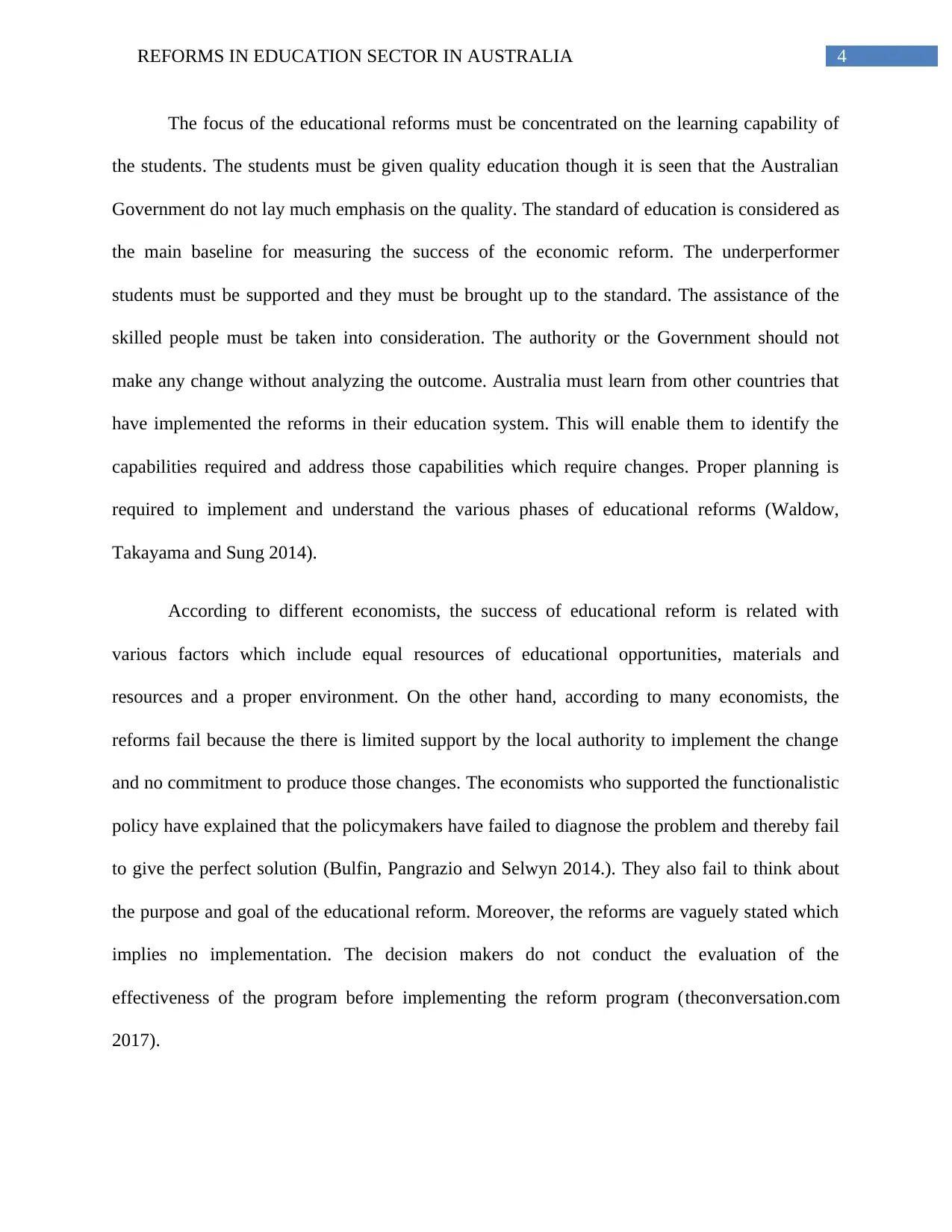
4REFORMS IN EDUCATION SECTOR IN AUSTRALIA
The focus of the educational reforms must be concentrated on the learning capability of
the students. The students must be given quality education though it is seen that the Australian
Government do not lay much emphasis on the quality. The standard of education is considered as
the main baseline for measuring the success of the economic reform. The underperformer
students must be supported and they must be brought up to the standard. The assistance of the
skilled people must be taken into consideration. The authority or the Government should not
make any change without analyzing the outcome. Australia must learn from other countries that
have implemented the reforms in their education system. This will enable them to identify the
capabilities required and address those capabilities which require changes. Proper planning is
required to implement and understand the various phases of educational reforms (Waldow,
Takayama and Sung 2014).
According to different economists, the success of educational reform is related with
various factors which include equal resources of educational opportunities, materials and
resources and a proper environment. On the other hand, according to many economists, the
reforms fail because the there is limited support by the local authority to implement the change
and no commitment to produce those changes. The economists who supported the functionalistic
policy have explained that the policymakers have failed to diagnose the problem and thereby fail
to give the perfect solution (Bulfin, Pangrazio and Selwyn 2014.). They also fail to think about
the purpose and goal of the educational reform. Moreover, the reforms are vaguely stated which
implies no implementation. The decision makers do not conduct the evaluation of the
effectiveness of the program before implementing the reform program (theconversation.com
2017).
The focus of the educational reforms must be concentrated on the learning capability of
the students. The students must be given quality education though it is seen that the Australian
Government do not lay much emphasis on the quality. The standard of education is considered as
the main baseline for measuring the success of the economic reform. The underperformer
students must be supported and they must be brought up to the standard. The assistance of the
skilled people must be taken into consideration. The authority or the Government should not
make any change without analyzing the outcome. Australia must learn from other countries that
have implemented the reforms in their education system. This will enable them to identify the
capabilities required and address those capabilities which require changes. Proper planning is
required to implement and understand the various phases of educational reforms (Waldow,
Takayama and Sung 2014).
According to different economists, the success of educational reform is related with
various factors which include equal resources of educational opportunities, materials and
resources and a proper environment. On the other hand, according to many economists, the
reforms fail because the there is limited support by the local authority to implement the change
and no commitment to produce those changes. The economists who supported the functionalistic
policy have explained that the policymakers have failed to diagnose the problem and thereby fail
to give the perfect solution (Bulfin, Pangrazio and Selwyn 2014.). They also fail to think about
the purpose and goal of the educational reform. Moreover, the reforms are vaguely stated which
implies no implementation. The decision makers do not conduct the evaluation of the
effectiveness of the program before implementing the reform program (theconversation.com
2017).
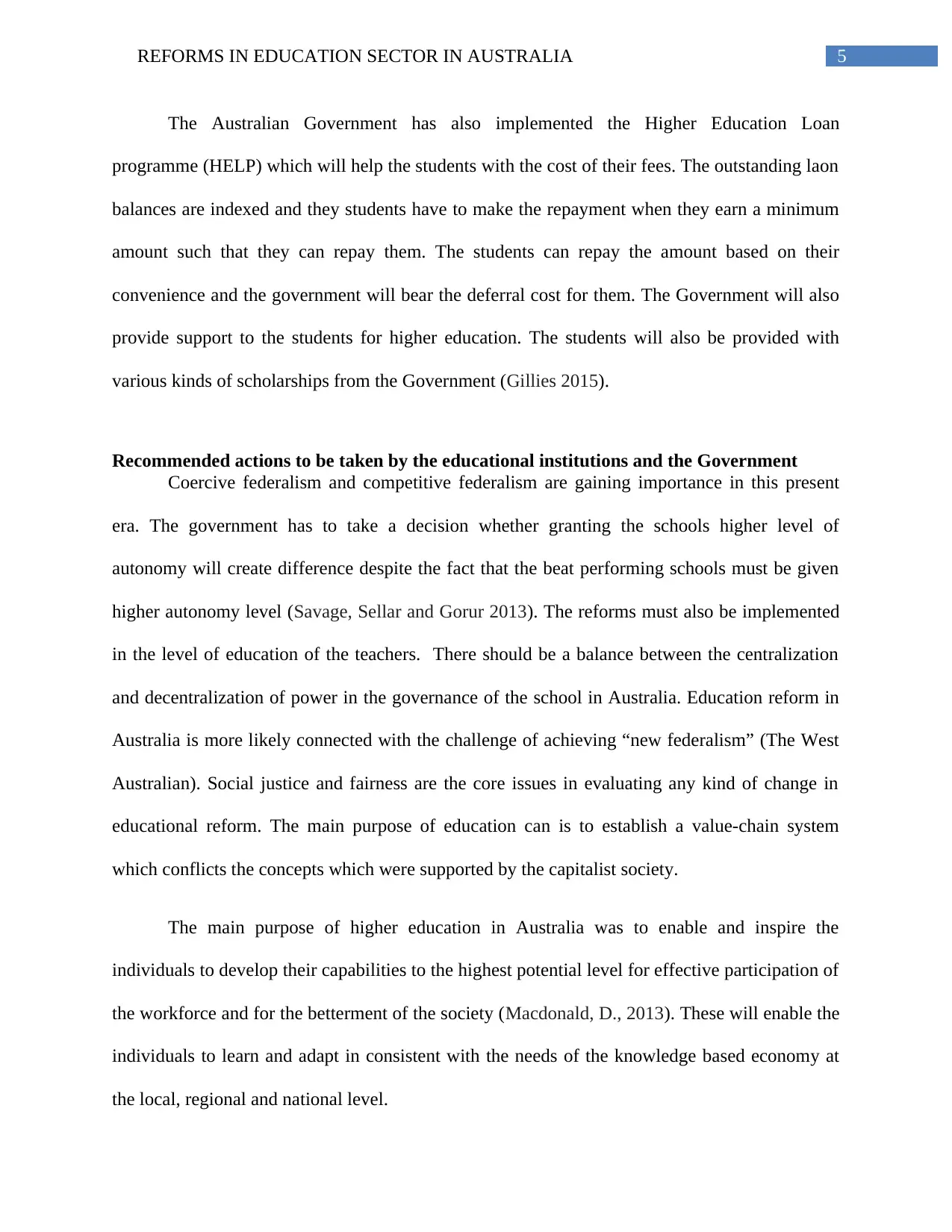
5REFORMS IN EDUCATION SECTOR IN AUSTRALIA
The Australian Government has also implemented the Higher Education Loan
programme (HELP) which will help the students with the cost of their fees. The outstanding laon
balances are indexed and they students have to make the repayment when they earn a minimum
amount such that they can repay them. The students can repay the amount based on their
convenience and the government will bear the deferral cost for them. The Government will also
provide support to the students for higher education. The students will also be provided with
various kinds of scholarships from the Government (Gillies 2015).
Recommended actions to be taken by the educational institutions and the Government
Coercive federalism and competitive federalism are gaining importance in this present
era. The government has to take a decision whether granting the schools higher level of
autonomy will create difference despite the fact that the beat performing schools must be given
higher autonomy level (Savage, Sellar and Gorur 2013). The reforms must also be implemented
in the level of education of the teachers. There should be a balance between the centralization
and decentralization of power in the governance of the school in Australia. Education reform in
Australia is more likely connected with the challenge of achieving “new federalism” (The West
Australian). Social justice and fairness are the core issues in evaluating any kind of change in
educational reform. The main purpose of education can is to establish a value-chain system
which conflicts the concepts which were supported by the capitalist society.
The main purpose of higher education in Australia was to enable and inspire the
individuals to develop their capabilities to the highest potential level for effective participation of
the workforce and for the betterment of the society (Macdonald, D., 2013). These will enable the
individuals to learn and adapt in consistent with the needs of the knowledge based economy at
the local, regional and national level.
The Australian Government has also implemented the Higher Education Loan
programme (HELP) which will help the students with the cost of their fees. The outstanding laon
balances are indexed and they students have to make the repayment when they earn a minimum
amount such that they can repay them. The students can repay the amount based on their
convenience and the government will bear the deferral cost for them. The Government will also
provide support to the students for higher education. The students will also be provided with
various kinds of scholarships from the Government (Gillies 2015).
Recommended actions to be taken by the educational institutions and the Government
Coercive federalism and competitive federalism are gaining importance in this present
era. The government has to take a decision whether granting the schools higher level of
autonomy will create difference despite the fact that the beat performing schools must be given
higher autonomy level (Savage, Sellar and Gorur 2013). The reforms must also be implemented
in the level of education of the teachers. There should be a balance between the centralization
and decentralization of power in the governance of the school in Australia. Education reform in
Australia is more likely connected with the challenge of achieving “new federalism” (The West
Australian). Social justice and fairness are the core issues in evaluating any kind of change in
educational reform. The main purpose of education can is to establish a value-chain system
which conflicts the concepts which were supported by the capitalist society.
The main purpose of higher education in Australia was to enable and inspire the
individuals to develop their capabilities to the highest potential level for effective participation of
the workforce and for the betterment of the society (Macdonald, D., 2013). These will enable the
individuals to learn and adapt in consistent with the needs of the knowledge based economy at
the local, regional and national level.
⊘ This is a preview!⊘
Do you want full access?
Subscribe today to unlock all pages.

Trusted by 1+ million students worldwide
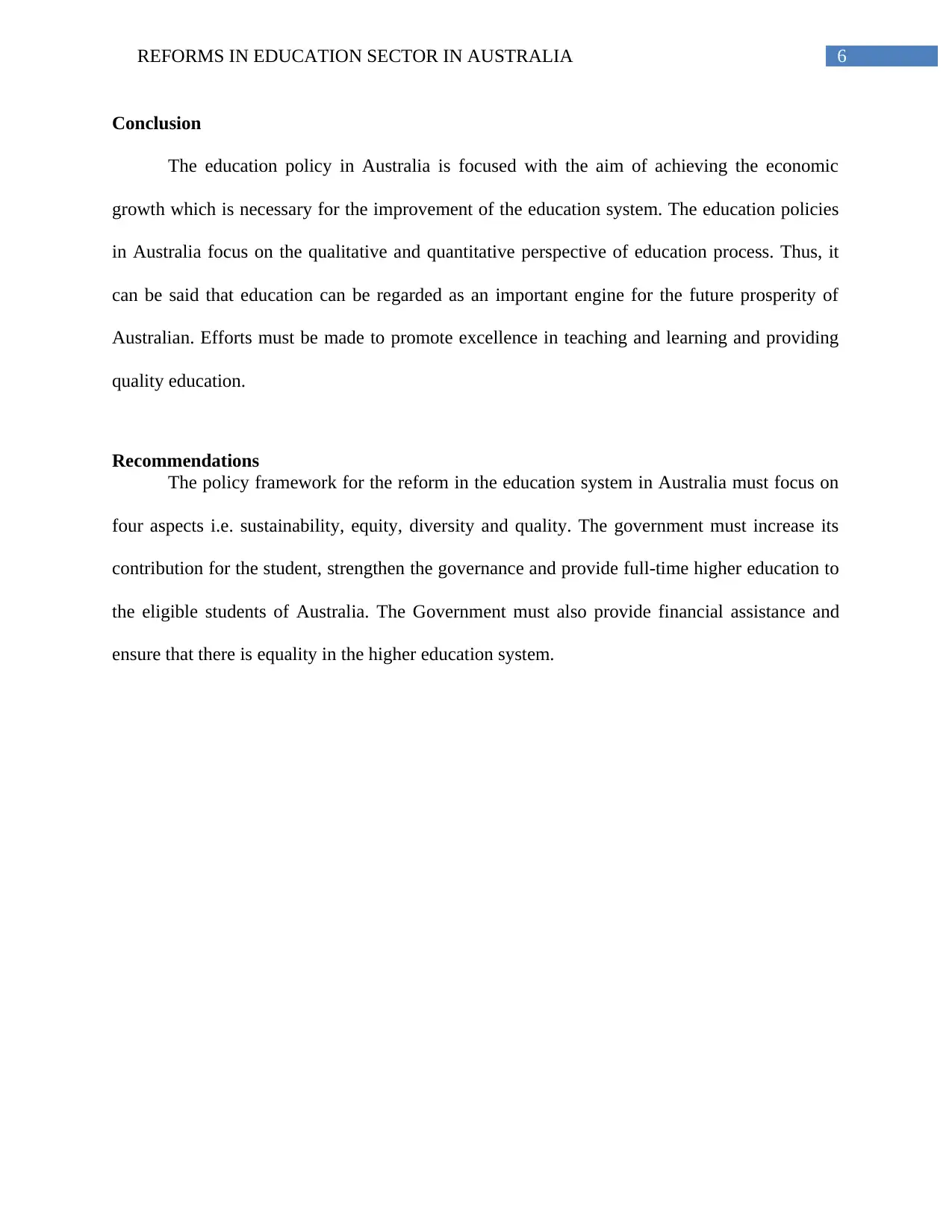
6REFORMS IN EDUCATION SECTOR IN AUSTRALIA
Conclusion
The education policy in Australia is focused with the aim of achieving the economic
growth which is necessary for the improvement of the education system. The education policies
in Australia focus on the qualitative and quantitative perspective of education process. Thus, it
can be said that education can be regarded as an important engine for the future prosperity of
Australian. Efforts must be made to promote excellence in teaching and learning and providing
quality education.
Recommendations
The policy framework for the reform in the education system in Australia must focus on
four aspects i.e. sustainability, equity, diversity and quality. The government must increase its
contribution for the student, strengthen the governance and provide full-time higher education to
the eligible students of Australia. The Government must also provide financial assistance and
ensure that there is equality in the higher education system.
Conclusion
The education policy in Australia is focused with the aim of achieving the economic
growth which is necessary for the improvement of the education system. The education policies
in Australia focus on the qualitative and quantitative perspective of education process. Thus, it
can be said that education can be regarded as an important engine for the future prosperity of
Australian. Efforts must be made to promote excellence in teaching and learning and providing
quality education.
Recommendations
The policy framework for the reform in the education system in Australia must focus on
four aspects i.e. sustainability, equity, diversity and quality. The government must increase its
contribution for the student, strengthen the governance and provide full-time higher education to
the eligible students of Australia. The Government must also provide financial assistance and
ensure that there is equality in the higher education system.
Paraphrase This Document
Need a fresh take? Get an instant paraphrase of this document with our AI Paraphraser
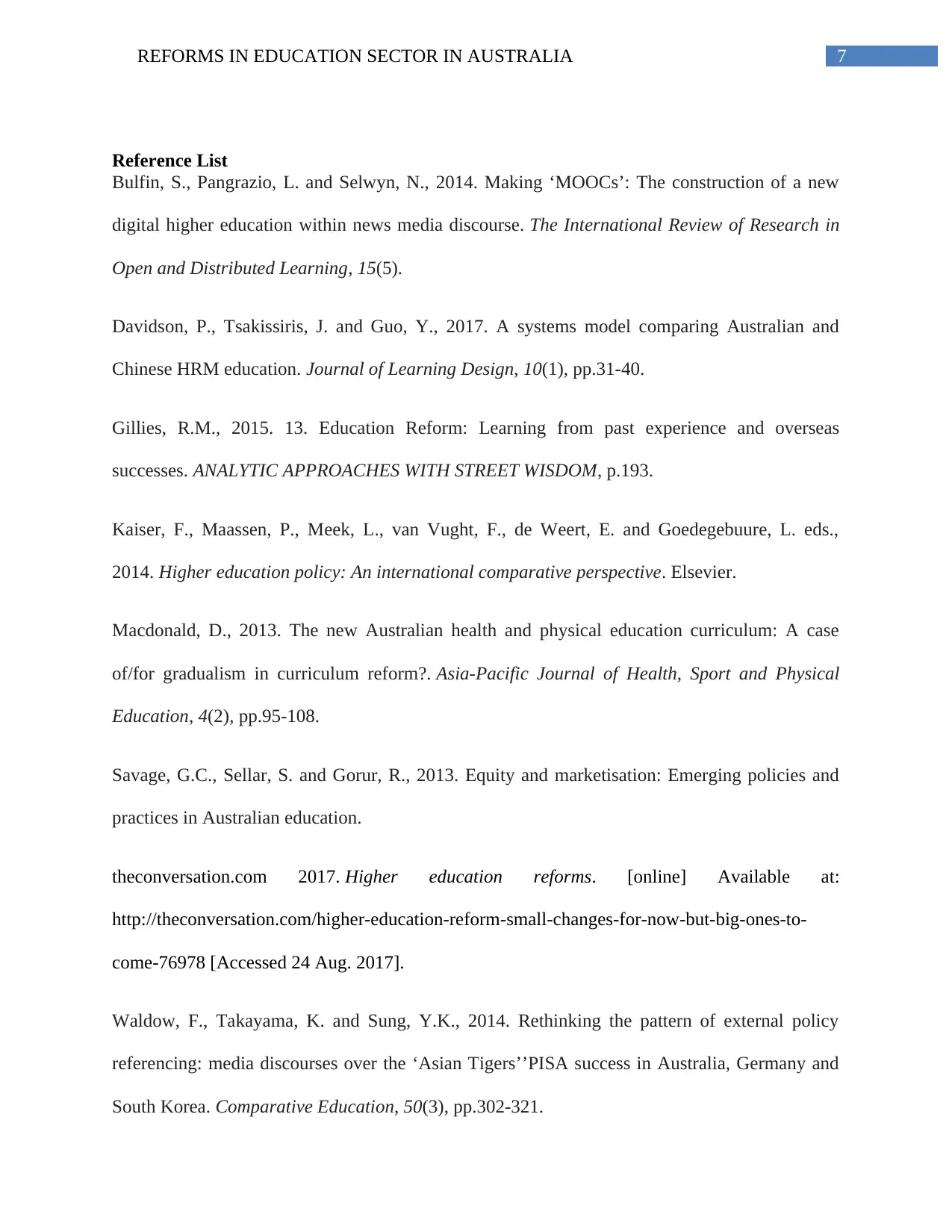
7REFORMS IN EDUCATION SECTOR IN AUSTRALIA
Reference List
Bulfin, S., Pangrazio, L. and Selwyn, N., 2014. Making ‘MOOCs’: The construction of a new
digital higher education within news media discourse. The International Review of Research in
Open and Distributed Learning, 15(5).
Davidson, P., Tsakissiris, J. and Guo, Y., 2017. A systems model comparing Australian and
Chinese HRM education. Journal of Learning Design, 10(1), pp.31-40.
Gillies, R.M., 2015. 13. Education Reform: Learning from past experience and overseas
successes. ANALYTIC APPROACHES WITH STREET WISDOM, p.193.
Kaiser, F., Maassen, P., Meek, L., van Vught, F., de Weert, E. and Goedegebuure, L. eds.,
2014. Higher education policy: An international comparative perspective. Elsevier.
Macdonald, D., 2013. The new Australian health and physical education curriculum: A case
of/for gradualism in curriculum reform?. Asia-Pacific Journal of Health, Sport and Physical
Education, 4(2), pp.95-108.
Savage, G.C., Sellar, S. and Gorur, R., 2013. Equity and marketisation: Emerging policies and
practices in Australian education.
theconversation.com 2017. Higher education reforms. [online] Available at:
http://theconversation.com/higher-education-reform-small-changes-for-now-but-big-ones-to-
come-76978 [Accessed 24 Aug. 2017].
Waldow, F., Takayama, K. and Sung, Y.K., 2014. Rethinking the pattern of external policy
referencing: media discourses over the ‘Asian Tigers’’PISA success in Australia, Germany and
South Korea. Comparative Education, 50(3), pp.302-321.
Reference List
Bulfin, S., Pangrazio, L. and Selwyn, N., 2014. Making ‘MOOCs’: The construction of a new
digital higher education within news media discourse. The International Review of Research in
Open and Distributed Learning, 15(5).
Davidson, P., Tsakissiris, J. and Guo, Y., 2017. A systems model comparing Australian and
Chinese HRM education. Journal of Learning Design, 10(1), pp.31-40.
Gillies, R.M., 2015. 13. Education Reform: Learning from past experience and overseas
successes. ANALYTIC APPROACHES WITH STREET WISDOM, p.193.
Kaiser, F., Maassen, P., Meek, L., van Vught, F., de Weert, E. and Goedegebuure, L. eds.,
2014. Higher education policy: An international comparative perspective. Elsevier.
Macdonald, D., 2013. The new Australian health and physical education curriculum: A case
of/for gradualism in curriculum reform?. Asia-Pacific Journal of Health, Sport and Physical
Education, 4(2), pp.95-108.
Savage, G.C., Sellar, S. and Gorur, R., 2013. Equity and marketisation: Emerging policies and
practices in Australian education.
theconversation.com 2017. Higher education reforms. [online] Available at:
http://theconversation.com/higher-education-reform-small-changes-for-now-but-big-ones-to-
come-76978 [Accessed 24 Aug. 2017].
Waldow, F., Takayama, K. and Sung, Y.K., 2014. Rethinking the pattern of external policy
referencing: media discourses over the ‘Asian Tigers’’PISA success in Australia, Germany and
South Korea. Comparative Education, 50(3), pp.302-321.
1 out of 8
Related Documents
Your All-in-One AI-Powered Toolkit for Academic Success.
+13062052269
info@desklib.com
Available 24*7 on WhatsApp / Email
![[object Object]](/_next/static/media/star-bottom.7253800d.svg)
Unlock your academic potential
Copyright © 2020–2025 A2Z Services. All Rights Reserved. Developed and managed by ZUCOL.





